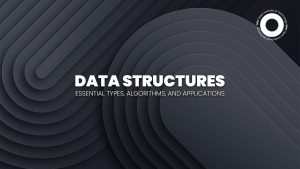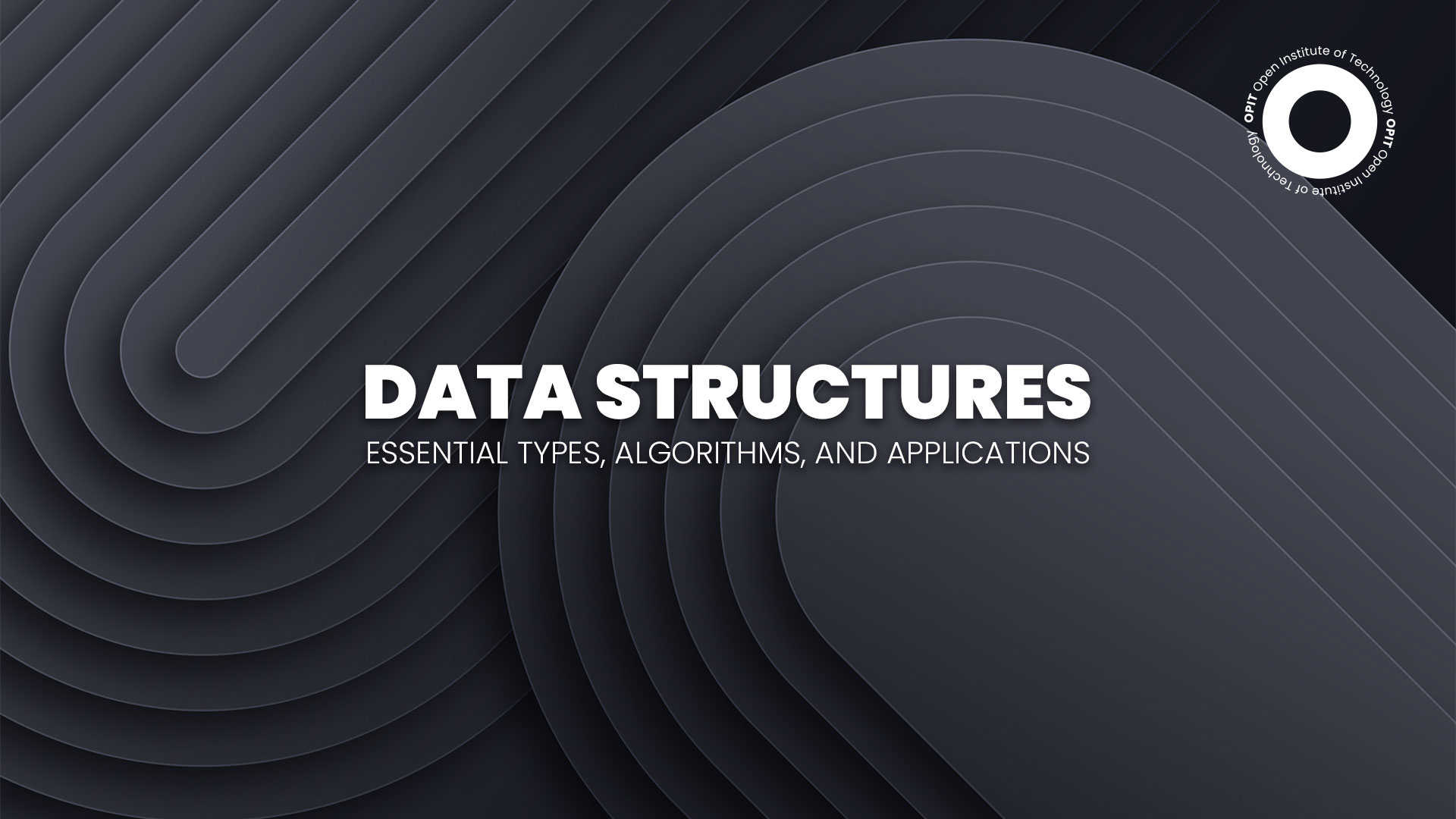

Data is the heartbeat of the digital realm. And when something is so important, you want to ensure you deal with it properly. That’s where data structures come into play.
But what is data structure exactly?
In the simplest terms, a data structure is a way of organizing data on a computing machine so that you can access and update it as quickly and efficiently as possible. For those looking for a more detailed data structure definition, we must add processing, retrieving, and storing data to the purposes of this specialized format.
With this in mind, the importance of data structures becomes quite clear. Neither humans nor machines could access or use digital data without these structures.
But using data structures isn’t enough on its own. You must also use the right data structure for your needs.
This article will guide you through the most common types of data structures, explain the relationship between data structures and algorithms, and showcase some real-world applications of these structures.
Armed with this invaluable knowledge, choosing the right data structure will be a breeze.
Types of Data Structures
Like data, data structures have specific characteristics, features, and applications. These are the factors that primarily dictate which data structure should be used in which scenario. Below are the most common types of data structures and their applications.
Primitive Data Structures
Take one look at the name of this data type, and its structure won’t surprise you. Primitive data structures are to data what cells are to a human body – building blocks. As such, they hold a single value and are typically built into programming languages. Whether you check data structures in C or data structures in Java, these are the types of data structures you’ll find.
- Integer (signed or unsigned) – Representing whole numbers
- Float (floating-point numbers) – Representing real numbers with decimal precision
- Character – Representing integer values as symbols
- Boolean – Storing true or false logical values
Non-Primitive Data Structures
Combine primitive data structures, and you get non-primitive data structures. These structures can be further divided into two types.
Linear Data Structures
As the name implies, a linear data structure arranges the data elements linearly (sequentially). In this structure, each element is attached to its predecessor and successor.
The most commonly used linear data structures (and their real-life applications) include the following:
- In arrays, multiple elements of the same type are stored together in the same location. As a result, they can all be processed relatively quickly. (library management systems, ticket booking systems, mobile phone contacts, etc.)
- Linked lists. With linked lists, elements aren’t stored at adjacent memory locations. Instead, the elements are linked with pointers indicating the next element in the sequence. (music playlists, social media feeds, etc.)
- These data structures follow the Last-In-First-Out (LIFO) sequencing order. As a result, you can only enter or retrieve data from one stack end (browsing history, undo operations in word processors, etc.)
- Queues follow the First-In-First-Out (FIFO) sequencing order (website traffic, printer task scheduling, video queues, etc.)
Non-Linear Data Structures
A non-linear data structure also has a pretty self-explanatory name. The elements aren’t placed linearly. This also means you can’t traverse all of them in a single run.
- Trees are tree-like (no surprise there!) hierarchical data structures. These structures consist of nodes, each filled with specific data (routers in computer networks, database indexing, etc.)
- Combine vertices (or nodes) and edges, and you get a graph. These data structures are used to solve the most challenging programming problems (modeling, computation flow, etc.)
Advanced Data Structures
Venture beyond primitive data structures (building blocks for data structures) and basic non-primitive data structures (building blocks for more sophisticated applications), and you’ll reach advanced data structures.
- Hash tables. These advanced data structures use hash functions to store data associatively (through key-value pairs). Using the associated values, you can quickly access the desired data (dictionaries, browser searching, etc.)
- Heaps are specialized tree-like data structures that satisfy the heap property (every tree element is larger than its descendant.)
- Tries store strings that can be organized in a visual graph and retrieved when necessary (auto-complete function, spell checkers, etc.)
Algorithms for Data Structures
There is a common misconception that data structures and algorithms in Java and other programming languages are one and the same. In reality, algorithms are steps used to structure data and solve other problems. Check out our overview of some basic algorithms for data structures.
Searching Algorithms
Searching algorithms are used to locate specific elements within data structures. Whether you’re searching for specific data structures in C++ or another programming language, you can use two types of algorithms:
- Linear search: starts from one end and checks each sequential element until the desired element is located
- Binary search: looks for the desired element in the middle of a sorted list of items (If the elements aren’t sorted, you must do that before a binary search.)
Sorting Algorithms
Whenever you need to arrange elements in a specific order, you’ll need sorting algorithms.
- Bubble sort: Compares two adjacent elements and swaps them if they’re in the wrong order
- Selection sort: Sorts lists by identifying the smallest element and placing it at the beginning of the unsorted list
- Insertion sort: Inserts the unsorted element in the correct position straight away
- Merge sort: Divides unsorted lists into smaller sections and orders each separately (the so-called divide-and-conquer principle)
- Quick sort: Also relies on the divide-and-conquer principle but employs a pivot element to partition the list (elements smaller than the pivot element go back, while larger ones are kept on the right)
Tree Traversal Algorithms
To traverse a tree means to visit its every node. Since trees aren’t linear data structures, there’s more than one way to traverse them.
- Pre-order traversal: Visits the root node first (the topmost node in a tree), followed by the left and finally the right subtree
- In-order traversal: Starts with the left subtree, moves to the root node, and ends with the right subtree
- Post-order traversal: Visits the nodes in the following order: left subtree, right subtree, the root node
Graph Traversal Algorithms
Graph traversal algorithms traverse all the vertices (or nodes) and edges in a graph. You can choose between two:
- Depth-first search – Focuses on visiting all the vertices or nodes of a graph data structure located one above the other
- Breadth-first search – Traverses the adjacent nodes of a graph before moving outwards
Applications of Data Structures
Data structures are critical for managing data. So, no wonder their extensive list of applications keeps growing virtually every day. Check out some of the most popular applications data structures have nowadays.
Data Organization and Storage
With this application, data structures return to their roots: they’re used to arrange and store data most efficiently.
Database Management Systems
Database management systems are software programs used to define, store, manipulate, and protect data in a single location. These systems have several components, each relying on data structures to handle records to some extent.
Let’s take a library management system as an example. Data structures are used every step of the way, from indexing books (based on the author’s name, the book’s title, genre, etc.) to storing e-books.
File Systems
File systems use specific data structures to represent information, allocate it to the memory, and manage it afterward.
Data Retrieval and Processing
With data structures, data isn’t stored and then forgotten. It can also be retrieved and processed as necessary.
Search Engines
Search engines (Google, Bing, Yahoo, etc.) are arguably the most widely used applications of data structures. Thanks to structures like tries and hash tables, search engines can successfully index web pages and retrieve the information internet users seek.
Data Compression
Data compression aims to accurately represent data using the smallest storage amount possible. But without data structures, there wouldn’t be data compression algorithms.
Data Encryption
Data encryption is crucial for preserving data confidentiality. And do you know what’s crucial for supporting cryptography algorithms? That’s right, data structures. Once the data is encrypted, data structures like hash tables also aid with value key storage.
Problem Solving and Optimization
At their core, data structures are designed for optimizing data and solving specific problems (both simple and complex). Throw their composition into the mix, and you’ll understand why these structures have been embraced by fields that heavily rely on mathematics and algorithms for problem-solving.
Artificial Intelligence
Artificial intelligence (AI) is all about data. For machines to be able to use this data, it must be properly stored and organized. Enter data structures.
Arrays, linked lists, queues, graphs, and stacks are just some structures used to store data for AI purposes.
Machine Learning
Data structures used for machine learning (MI) are pretty similar to other computer science fields, including AI. In machine learning, data structures (both linear and non-linear) are used to solve complex mathematical problems, manipulate data, and implement ML models.
Network Routing
Network routing refers to establishing paths through one or more internet networks. Various routing algorithms are used for this purpose and most heavily rely on data structures to find the best patch for the incoming data packet.
Data Structures: The Backbone of Efficiency
Data structures are critical in our data-driven world. They allow straightforward data representation, access, and manipulation, even in giant databases. For this reason, learning about data structures and algorithms further can open up a world of possibilities for a career in data science and related fields.
Related posts

Source:
- Agenda Digitale, published on November 25th, 2025
In recent years, the word ” sustainability ” has become a firm fixture in the corporate lexicon. However, simply “doing no harm” is no longer enough: the climate crisis , social inequalities , and the erosion of natural resources require a change of pace. This is where the net-positive paradigm comes in , a model that isn’t content to simply reduce negative impacts, but aims to generate more social and environmental value than is consumed.
This isn’t about philanthropy, nor is it about reputational makeovers: net-positive is a strategic approach that intertwines economics, technology, and corporate culture. Within this framework, digitalization becomes an essential lever, capable of enabling regenerative models through circular platforms and exponential technologies.
Blockchain, AI, and IoT: The Technological Triad of Regeneration
Blockchain, Artificial Intelligence, and the Internet of Things represent the technological triad that makes this paradigm shift possible. Each addresses a critical point in regeneration.
Blockchain guarantees the traceability of material flows and product life cycles, allowing a regenerated dress or a bottle collected at sea to tell their story in a transparent and verifiable way.
Artificial Intelligence optimizes recovery and redistribution chains, predicting supply and demand, reducing waste and improving the efficiency of circular processes .
Finally, IoT enables real-time monitoring, from sensors installed at recycling plants to sharing mobility platforms, returning granular data for quick, informed decisions.
These integrated technologies allow us to move beyond linear vision and enable systems in which value is continuously regenerated.
New business models: from product-as-a-service to incentive tokens
Digital regeneration is n’t limited to the technological dimension; it’s redefining business models. More and more companies are adopting product-as-a-service approaches , transforming goods into services: from technical clothing rentals to pay-per-use for industrial machinery. This approach reduces resource consumption and encourages modular design, designed for reuse.
At the same time, circular marketplaces create ecosystems where materials, components, and products find new life. No longer waste, but input for other production processes. The logic of scarcity is overturned in an economy of regenerated abundance.
To complete the picture, incentive tokens — digital tools that reward virtuous behavior, from collecting plastic from the sea to reusing used clothing — activate global communities and catalyze private capital for regeneration.
Measuring Impact: Integrated Metrics for Net-Positiveness
One of the main obstacles to the widespread adoption of net-positive models is the difficulty of measuring their impact. Traditional profit-focused accounting systems are not enough. They need to be combined with integrated metrics that combine ESG and ROI, such as impact-weighted accounting or innovative indicators like lifetime carbon savings.
In this way, companies can validate the scalability of their models and attract investors who are increasingly attentive to financial returns that go hand in hand with social and environmental returns.
Case studies: RePlanet Energy, RIFO, and Ogyre
Concrete examples demonstrate how the combination of circular platforms and exponential technologies can generate real value. RePlanet Energy has defined its Massive Transformative Purpose as “Enabling Regeneration” and is now providing sustainable energy to Nigerian schools and hospitals, thanks in part to transparent blockchain-based supply chains and the active contribution of employees. RIFO, a Tuscan circular fashion brand, regenerates textile waste into new clothing, supporting local artisans and promoting workplace inclusion, with transparency in the production process as a distinctive feature and driver of loyalty. Ogyre incentivizes fishermen to collect plastic during their fishing trips; the recovered material is digitally tracked and transformed into new products, while the global community participates through tokens and environmental compensation programs.
These cases demonstrate how regeneration and profitability are not contradictory, but can actually feed off each other, strengthening the competitiveness of businesses.
From Net Zero to Net Positive: The Role of Massive Transformative Purpose
The crucial point lies in the distinction between sustainability and regeneration. The former aims for net zero, that is, reducing the impact until it is completely neutralized. The latter goes further, aiming for a net positive, capable of giving back more than it consumes.
This shift in perspective requires a strong Massive Transformative Purpose: an inspiring and shared goal that guides strategic choices, preventing technology from becoming a sterile end. Without this level of intentionality, even the most advanced tools risk turning into gadgets with no impact.
Regenerating business also means regenerating skills to train a new generation of professionals capable not only of using technologies but also of directing them towards regenerative business models. From this perspective, training becomes the first step in a transformation that is simultaneously cultural, economic, and social.
The Regenerative Future: Technology, Skills, and Shared Value
Digital regeneration is not an abstract concept, but a concrete practice already being tested by companies in Europe and around the world. It’s an opportunity for businesses to redefine their role, moving from mere economic operators to drivers of net-positive value for society and the environment.
The combination of blockchain, AI, and IoT with circular product-as-a-service models, marketplaces, and incentive tokens can enable scalable and sustainable regenerative ecosystems. The future of business isn’t just measured in terms of margins, but in the ability to leave the world better than we found it.

Source:
- Raconteur, published on November 06th, 2025
Many firms have conducted successful Artificial Intelligence (AI) pilot projects, but scaling them across departments and workflows remains a challenge. Inference costs, data silos, talent gaps and poor alignment with business strategy are just some of the issues that leave organisations trapped in pilot purgatory. This inability to scale successful experiments means AI’s potential for improving enterprise efficiency, decision-making and innovation isn’t fully realised. So what’s the solution?
Although it’s not a magic bullet, an AI operating model is really the foundation for scaling pilot projects up to enterprise-wide deployments. Essentially it’s a structured framework that defines how the organisation develops, deploys and governs AI. By bringing together infrastructure, data, people, and governance in a flexible and secure way, it ensures that AI delivers value at scale while remaining ethical and compliant.
“A successful AI proof-of-concept is like building a single race car that can go fast,” says Professor Yu Xiong, chair of business analytics at the UK-based Surrey Business School. “An efficient AI technology operations model, however, is the entire system – the processes, tools, and team structures – for continuously manufacturing, maintaining, and safely operating an entire fleet of cars.”
But while the importance of this framework is clear, how should enterprises establish and embed it?
“It begins with a clear strategy that defines objectives, desired outcomes, and measurable success criteria, such as model performance, bias detection, and regulatory compliance metrics,” says Professor Azadeh Haratiannezhadi, co-founder of generative AI company Taktify and professor of generative AI in cybersecurity at OPIT – the Open Institute of Technology.
Platforms, tools and MLOps pipelines that enable models to be deployed, monitored and scaled in a safe and efficient way are also essential in practical terms.
“Tools and infrastructure must also be selected with transparency, cost, and governance in mind,” says Efrain Ruh, continental chief technology officer for Europe at Digitate. “Crucially, organisations need to continuously monitor the evolving AI landscape and adapt their models to new capabilities and market offerings.”
An open approach
The most effective AI operating models are also founded on openness, interoperability and modularity. Open source platforms and tools provide greater control over data, deployment environments and costs, for example. These characteristics can help enterprises to avoid vendor lock-in, successfully align AI to business culture and values, and embed it safely into cross-department workflows.
“Modularity and platformisation…avoids building isolated ‘silos’ for each project,” explains professor Xiong. “Instead, it provides a shared, reusable ‘AI platform’ that integrates toolchains for data preparation, model training, deployment, monitoring, and retraining. This drastically improves efficiency and reduces the cost of redundant work.”
A strong data strategy is equally vital for ensuring high-quality performance and reducing bias. Ideally, the AI operating model should be cloud and LLM agnostic too.
“This allows organisations to coordinate and orchestrate AI agents from various sources, whether that’s internal or 3rd party,” says Babak Hodjat, global chief technology officer of AI at Cognizant. “The interoperability also means businesses can adopt an agile iterative process for AI projects that is guided by measuring efficiency, productivity, and quality gains, while guaranteeing trust and safety are built into all elements of design and implementation.”
A robust AI operating model should feature clear objectives for compliance, security and data privacy, as well as accountability structures. Richard Corbridge, chief information officer of Segro, advises organisations to: “Start small with well-scoped pilots that solve real pain points, then bake in repeatable patterns, data contracts, test harnesses, explainability checks and rollback plans, so learning can be scaled without multiplying risk. If you don’t codify how models are approved, deployed, monitored and retired, you won’t get past pilot purgatory.”
Of course, technology alone can’t drive successful AI adoption at scale: the right skills and culture are also essential for embedding AI across the enterprise.
“Multidisciplinary teams that combine technical expertise in AI, security, and governance with deep business knowledge create a foundation for sustainable adoption,” says Professor Haratiannezhadi. “Ongoing training ensures staff acquire advanced AI skills while understanding associated risks and responsibilities.”
Ultimately, an AI operating model is the playbook that enables an enterprise to use AI responsibly and effectively at scale. By drawing together governance, technological infrastructure, cultural change and open collaboration, it supports the shift from isolated experiments to the kind of sustainable AI capability that can drive competitive advantage.
In other words, it’s the foundation for turning ambition into reality, and finally escaping pilot purgatory for good.
Have questions?
Visit our FAQ page or get in touch with us!
Write us at +39 335 576 0263
Get in touch at hello@opit.com
Talk to one of our Study Advisors
We are international
We can speak in:


